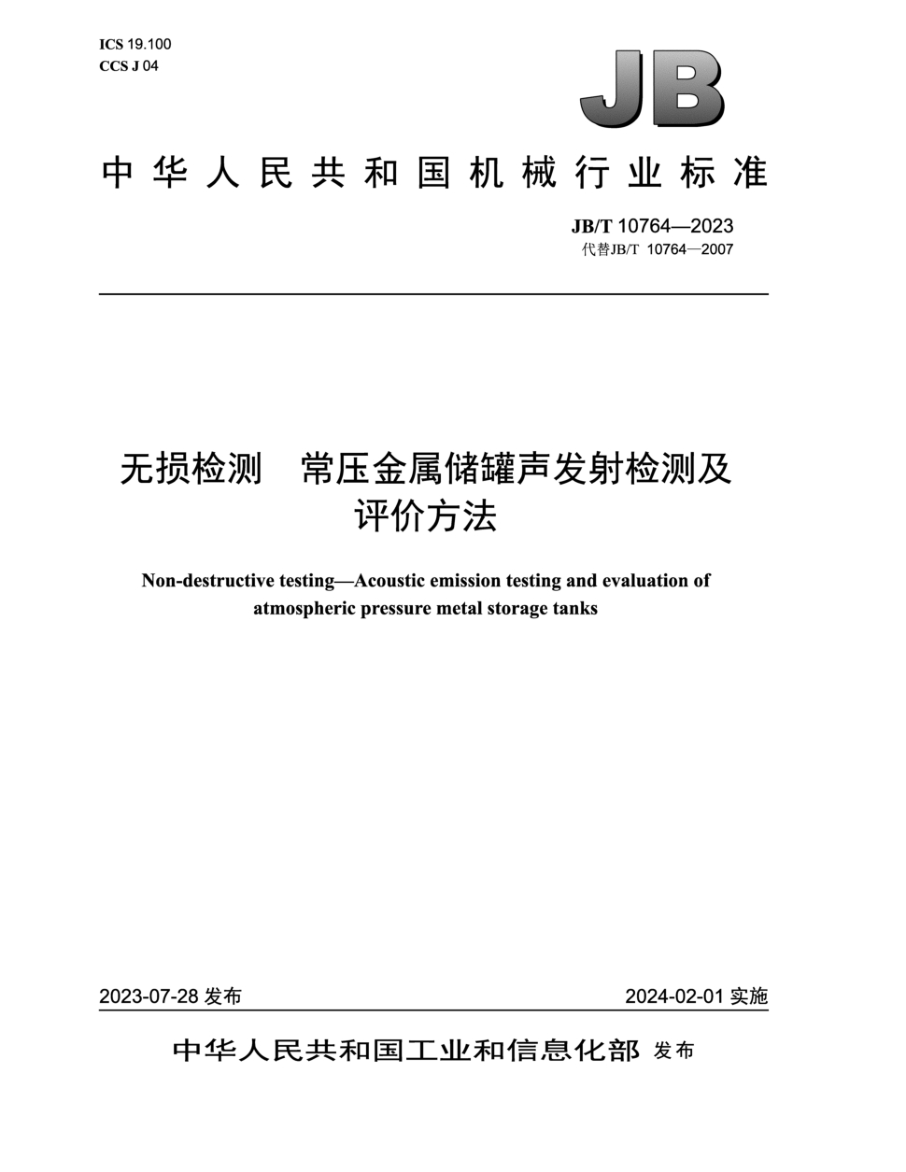-

JB/T 10764-2023 无损检测 常压金属储罐声发射检测及评价方法
本文件规定了常压金属储罐壁板与底板的声发射检测与评价方法。
本文件适用于工作介质为气体或液体、工作压力为常压或小于0.1MPa 的低压新制造和在用地上金属立式储罐壁板与底板的声发射检测。
替代JB/T 10764-2007...2024-04-18 01:00:01浏览:46
查看 -

ASTM F1797-2018 绝缘和非绝缘挖掘机吊杆声发射测试方法 Standard Test Method for Acoustic Emission Testing of Insulated and Non-Insulated Digger Derricks
1.1 This test method covers a procedure for acoustic emission (AE) testing of digger derricks. 1.1.1 Equipment Covered—This test method applies to special multipurpose vehicle-mounted machines, commonly known as digger derricks. These machines are primarily designed to dig holes, set poles, and position materials and apparatus. 1.1.1.1 Insulated and non-insulated type digger derricks may be evaluated with this test method. 1.1.1.2 Digger derricks, if so equipped to position personnel or equipment, or both, may also be evaluated with this test method in conjunction with Test Method F914. 1.1.2 Equipment Not Covered—Excluded from this test method are general-purpose cranes designed only for lifting service and machines primarily designed only for digging holes. 1.2 The AE test method is used to detect and area-locate emission sources. Verification of emission sources may require the use of other nondestructive test (NDT) methods, such as radiography, ultrasonic, magnetic particle, liquid penetrant, and visual inspection. 1.3 Warning—This test method requires that external loads be applied to the superstructure of the vehicle under test. During the test, caution must be taken to safeguard personnel and equipment against unexpected failure or instability of the vehicle or components. FIG. 1 Digger Derrick Nomenclature 1.4 This standard does not purport to address all of the safety concerns, if any, associated with its use. It is the responsibility of the user of this standard to establish appropriate safety, health, and environmental practices and determine the applicability of regulatory limitations prior to use. 1.5 This international standard was developed in accordance with internationally recognized principles on standardization established in the Decision on Principles for the Development of International Standards, Guides and Recommendations issued by the Wor...
2023-07-19 03:36:02浏览:36
查看 -

ASTM E1781/E1781M-2019 声发射传感器二级校准规程 Standard Practice for Secondary Calibration of Acoustic Emission Sensors
<div class="SectionLevel2"> <p class="subsec1 cdone2"><span class="Head3 cdone">1.1</span> This practice covers requirements for the secondary calibration of acoustic emission (AE) sensors. The secondary calibration yields the frequency response of a sensor to waves of the type normally encountered in acoustic emission work. The source producing the signal used for the calibration is mounted on the same surface of the test block as the sensor under testing (SUT). Rayleigh waves are dominant under these conditions; the calibration results represent primarily the sensor's sensitivity to Rayleigh waves. The sensitivity of the sensor is determined for excitation within the range of 100 kHz to 1 MHz. Sensitivity values are usually determined at frequencies approximately 10 kHz apart. The units of the calibration are volts per unit of mechanical input (displacement, velocity, or acceleration).</p></div> <div class="SectionLevel2"> <p class="subsec1 cdone2"><span class="Head3 cdone">1.2</span> <span class="Head3Title cdone">Units—</span>The values stated in either SI units or inch-pound units are to be regarded separately as standard. The values stated in each system are not necessarily exact equivalents; therefore, to ensure conformance with the standard, each system shall be used independently of the other, and values from the two systems shall not be combined.</p></div> <div class="SectionLevel2"> <p class="caveat cdone2"><span class="Head3 cdone">1.3</span> <i>This standard does not purport to address all of the safety concerns, if any, associated with its use. It is the responsibility of the user of this standard to establish appropriate safety, health, and environmental practices and determine the applicability of regulatory limitations prior to use.</i></p></div> <div class="SectionLevel2"> <p class="WTOcaveat cdone2"><span class="Head3 cdone">1.4</span> <i>This international standard was developed in accordance with internationall...
2023-06-10 15:48:01浏览:56
查看 -

-

-



